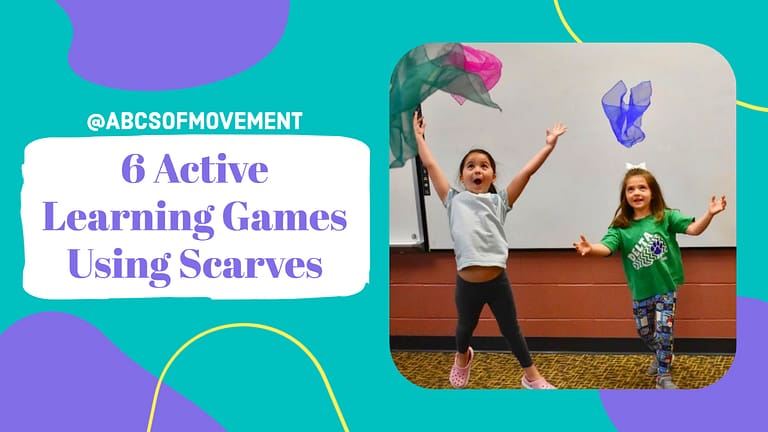
Spark Imagination and Curiosity
Scarf play is an excellent opportunity for preschool children to learn many developmental skills while swishing, floating, waving and tossing scarves. What looks like just fun and games is actually enhancing your child’s development in multiple areas.
For example..
- Improving eye-hand coordination during catching.
- Enhancing fine motor control when grabbing, tossing, and holding onto the scarf.
- Igniting imagination when we pretend using the scarves.
- Practicing self-regulation as we follow directions and take turns.
- Gain gross motor balance and coordination during active play based learning.
- Language skills and curiosity develop as we share our ideas and feelings.
Standards Based Activities
These are six activities you can do at home or school that are available for FREE at OPENPhysed. As a school based physical therapist, I use these lesson plans all the time because I can modify them into a great therapeutic tool for my students with special needs and they are standards based. If you missed the post about OPENPhysed or if you need to refresh your memory, please see THIS blog post for an introduction to OPENPhysed.org.
Who Can Play and Materials Needed
These six activity plans are designed for preschool age children. However, they are great to use with kindergarten age children and children with special needs, too. Each activity should take approximately 10 minutes and can be played indoors or outside.
We use colored scarves from USGames. The 15”x15” scarves float through the air when thrown. This allows young children to gain success with basic throwing and catching skills while building self-confidence when they succeed.
Ideally you should try to schedule 6 activity breaks throughout the day to provide the recommended 60 minutes of daily physical activity.
1. Low, Medium, High…Oh, My!
This activity teaches children to move their scarf at different levels. When the music (insert ABC’s of Movement) starts, children are encourage to wave their scarves and move to the music. When the music stops, freeze and stand tall. Next, you call out different levels: low, medium, high and children move their scarves as different levels are called. Lastly, ask children to call out an animal and wave their scarf to match the level of the animal. For example, if a child says, “mouse”, we all move our scarves at a low level. Children take turns calling out animals and wave their scarfs until everyone has had a turn.
2. Stand Like This
This active learning game challenges children’s balance as the adult calls out different ways to stand with their scarves balanced on different body parts. For example, stand with your feet wide apart, arms up, balance the scarf on your elbow. Or, stand on one foot with the scarf on your head.
3. Mirror Me
First children mirror your movements with the scarf, slowly then faster. Next, they try to mirror a partner by facing each other. After the first child had a chance to be the leader and the second child mirrored them, switch so the other child can be the leader. We know how much children LOVE to be the leader!
4. Tossing Challenges
This activity involves you prompting the children to complete a variety of tossing challenges for approximately 30 seconds each. For example, toss the scarf up, toss down, toss left, toss right, toss and clap, and toss and spin. Then put on the music and encourage children to make up their own tossing challenges as long as they are safe and stay within their personal space.
5. Tails
Imaginations are freely flowing as children are asked to name animals with tails. When the music starts, they are encouraged to hold their scarf behind their back, like a tail, and move like the animal. They can take turns naming animals with tails and all move together like that animal or, everyone can move as different animals with tails (while being safe) . You can challenge older preschoolers to categorize the animals. For example, “Let’s all be farm animals with tails or zoo animals with tails, or pets with tails”.
6. Scarf Fitness
In this activity we are all fitness buffs strengthening our muscles. When the music starts, you demonstrate some exercises with the scarf and the children follow along. Some examples would be hold the scarf and do jumping jacks, wave the scarf while jogging in place, pretend the scarf is a weight and perform dumbbell curls. Children are bound to feel their hearts beat while playing this face paced movement game.
Benefits
As you can see there are so many wonderful benefits of scarf play. Here are a few more! Giving children scarves to play and explore movement with always brings smiles to their faces. If you are you eager to try some other movement exploration activities check out Hoop Hoop Hooray! or Balance Shuffle.
